Back in 2018, Huw Evans explained the work done by the teams of DNEG on Mission: Impossible – Fallout. He then went on to work on Wonder Woman 1984.
Benjamin Cowell-Thomas has been working in visual effects for over 20 years. He joined DNEG in 2016 and worked on films such as Deadpool 2, Avengers: Endgame, Men in Black: International and Fast & Furious 9.
Keith Roberts has nearly 30 years of experience in animation. Prior to joining DNEG in 2019, he worked at numerous studios including MPC Rhythm & Hues and Method Studios. He has worked on films such as Thor: The Dark World, Ant-Man, Captain America: Civil War and Avengers: Infinity War.
Mike Nixon has been with DNEG since 2005. He has worked on a number of films including Green Zone, Man of Steel, Pacific Rim: Uprising and Greyhound.
How did you get involved in this movie?
Huw Evans (HJE) – I had a discussion with Overall Supervisor Dan Glass just before Christmas in December 2019 but I officially started in January 2020 after finishing up on WW84. Naturally, knowing that it was the next movie in The Matrix franchise, I jumped at the opportunity!
What did it feel like to be part of such an iconic universe?
HJE – Oh my goodness – like a dream come true! Like a lot of others, I was completely blown away by The Matrix when I first saw it in the cinema. I remember seeing the slightly cryptic trailers and went into it not knowing what to expect but it totally blew my mind, both in terms of story and concept, but also the insane and creative visuals. So to actually get to be a part of and help create a movie within this franchise was just an incredible experience for me, and I think it’s fair to say, for most of the team as well.
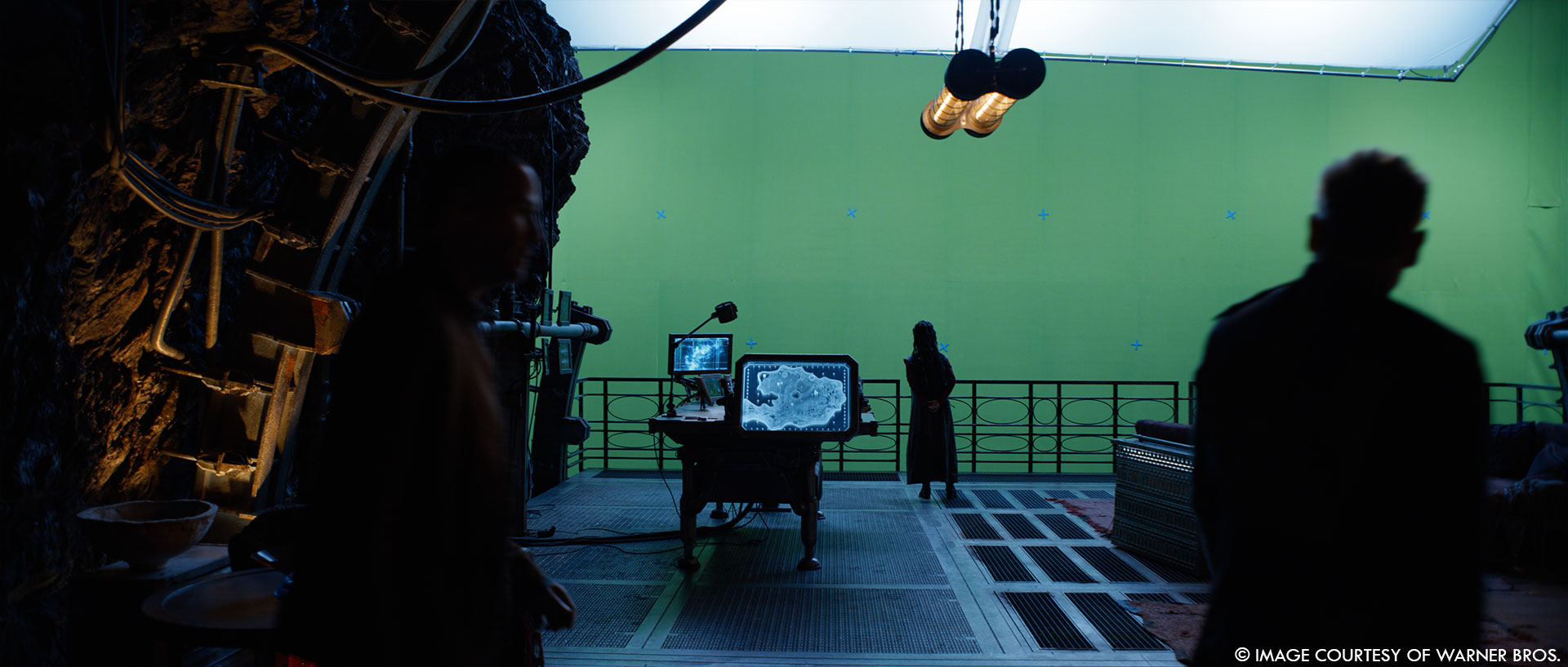
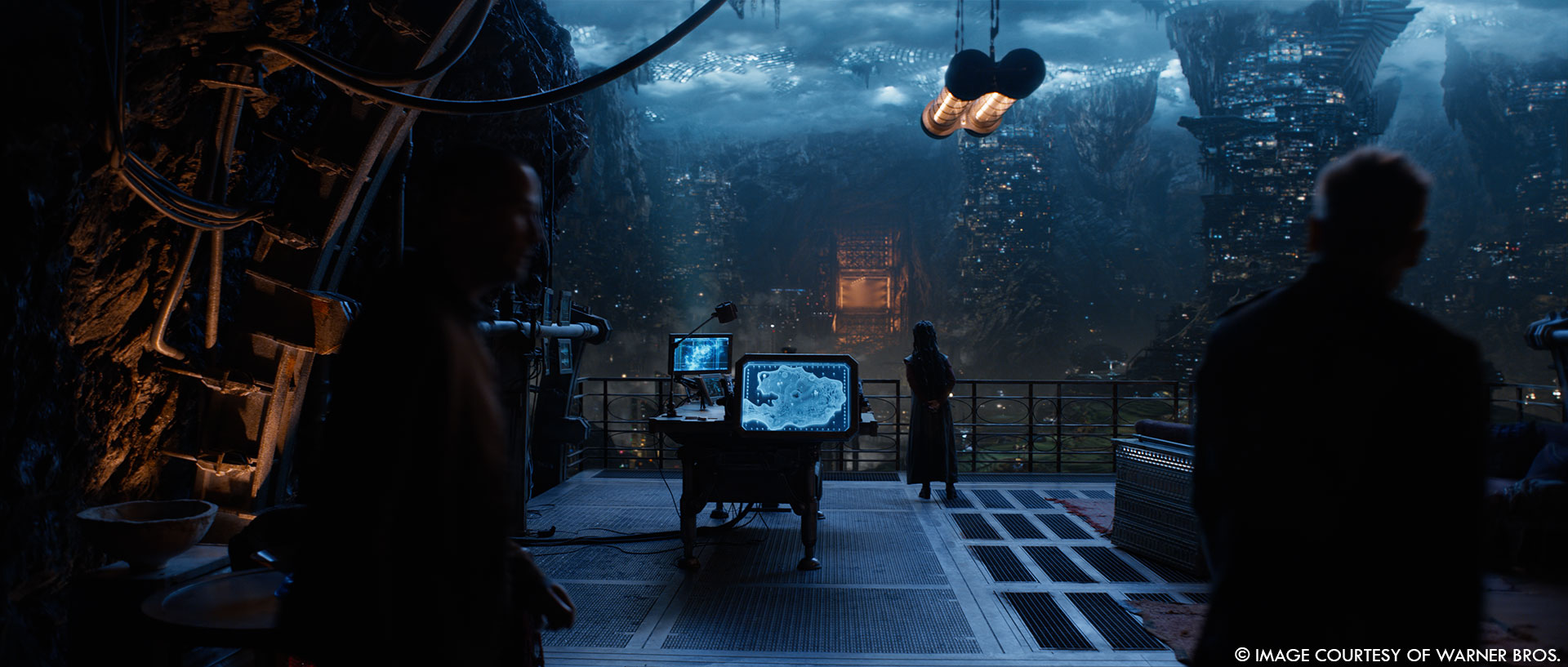
What was it like to collaborate with Director Lana Wachowski?
HJE – I hadn’t worked with Lana before but I was naturally very excited to meet her. With the global pandemic hitting and the shoot needing to go on hiatus, I was worried I might miss the Berlin portion of the shoot but luckily, as things partially opened up, I managed to join the shoot crew for a few months. Lana was warm, welcoming and a great collaborator. She had a clear vision and a distinct shooting style, which was far more intimate and documentary-like than the previous films in the trilogy and fascinating to watch. Even though she held this movie and this world inside her head, we’d sometimes be looking at our latest work in a meeting and we would come across a particular item that wasn’t yet designed for example. She would then give us the freedom to explore some creative ideas about what might be cool and I found being able to have that close dialogue with her was a huge asset and also very inspiring.
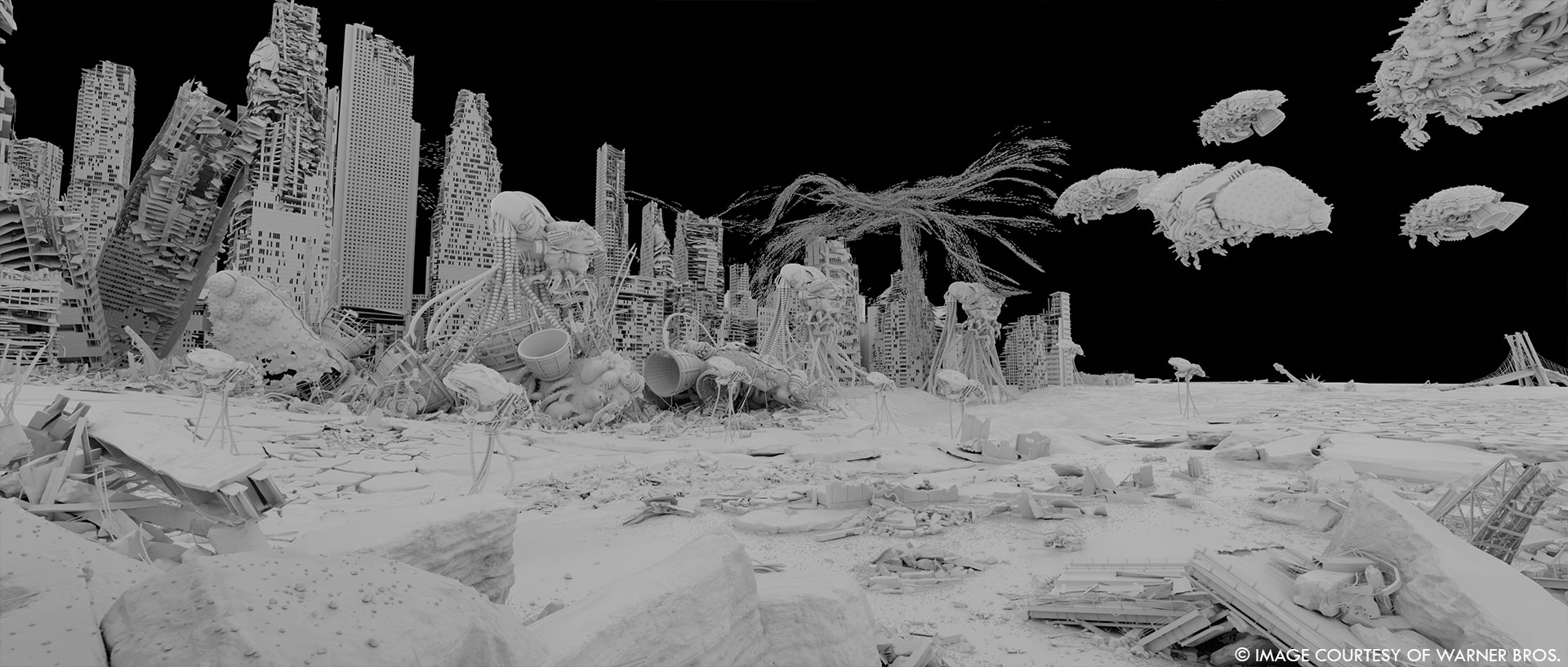
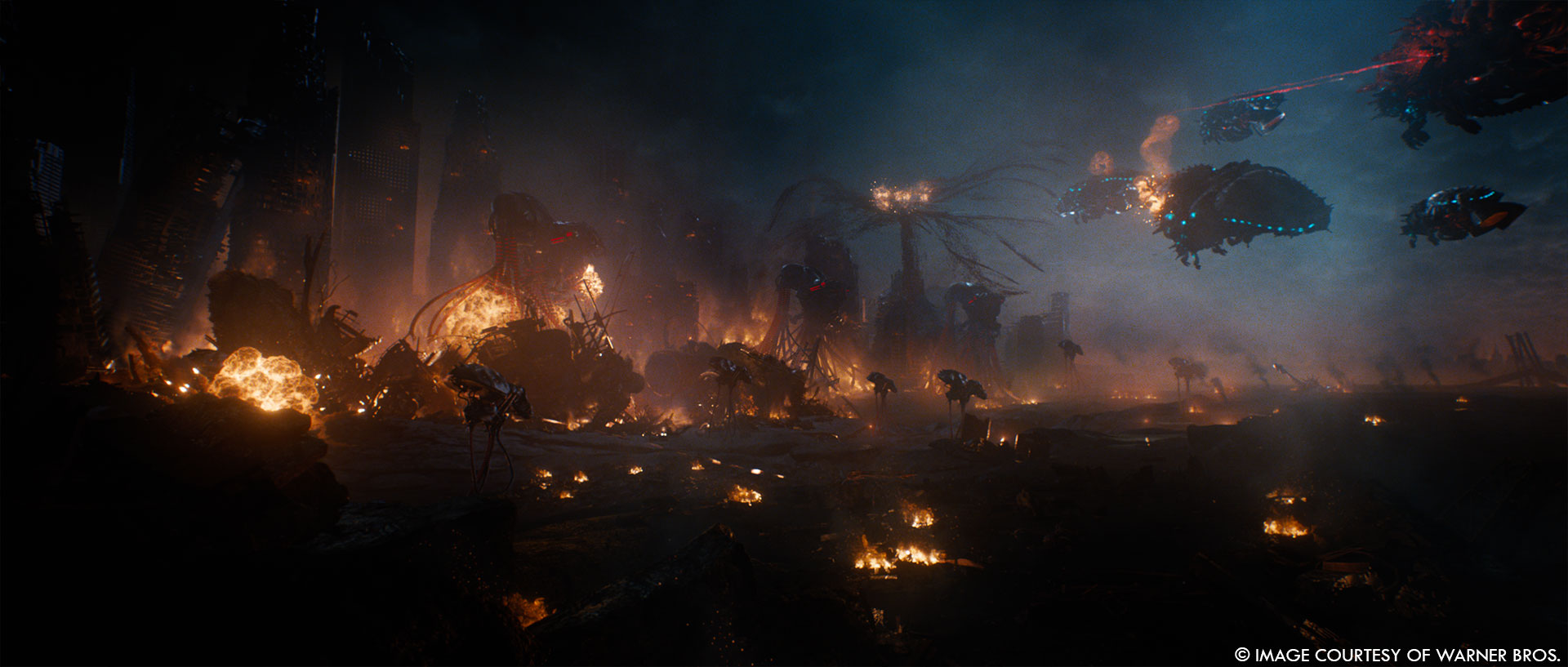
How would you describe her approach and expectations around the visual effects?
HJE – I think for this movie, the narrative is based around a different simulation of The Matrix than we’d seen in the previous movies so there was definitely a different look and feel required. Lana was keen to have real practical locations wherever possible and to capture as much in-camera as she could. Even the sets on the stages in Berlin were incredibly detailed and examples like the Mnemosyne ship interior required no VFX extension work other than some cleanup so that was a huge help for us. There was still plenty of greenscreen work and full CG shots to complete, but it was important that we matched to the style of Lana’s shooting and the lighting motifs that she’d been incorporating. It was very important for us to get it right. Due to the pandemic compressing the shoot schedule, we also had to come up with some creative solutions where we might not have been able to gather our usual clean plates or isolated passes, and we were incredibly mindful of any delays we might be adding to the day, no matter how small. The VFX team generally operate like ninjas on set sneaking in and out without being seen but this one required even more stealth and speed so we were lucky to have such a strong group on-set, headed up by Joseph Quinn and Aaron Roebuck. Can’t thank them and the rest of the team enough for what they managed to capture given the constraints.
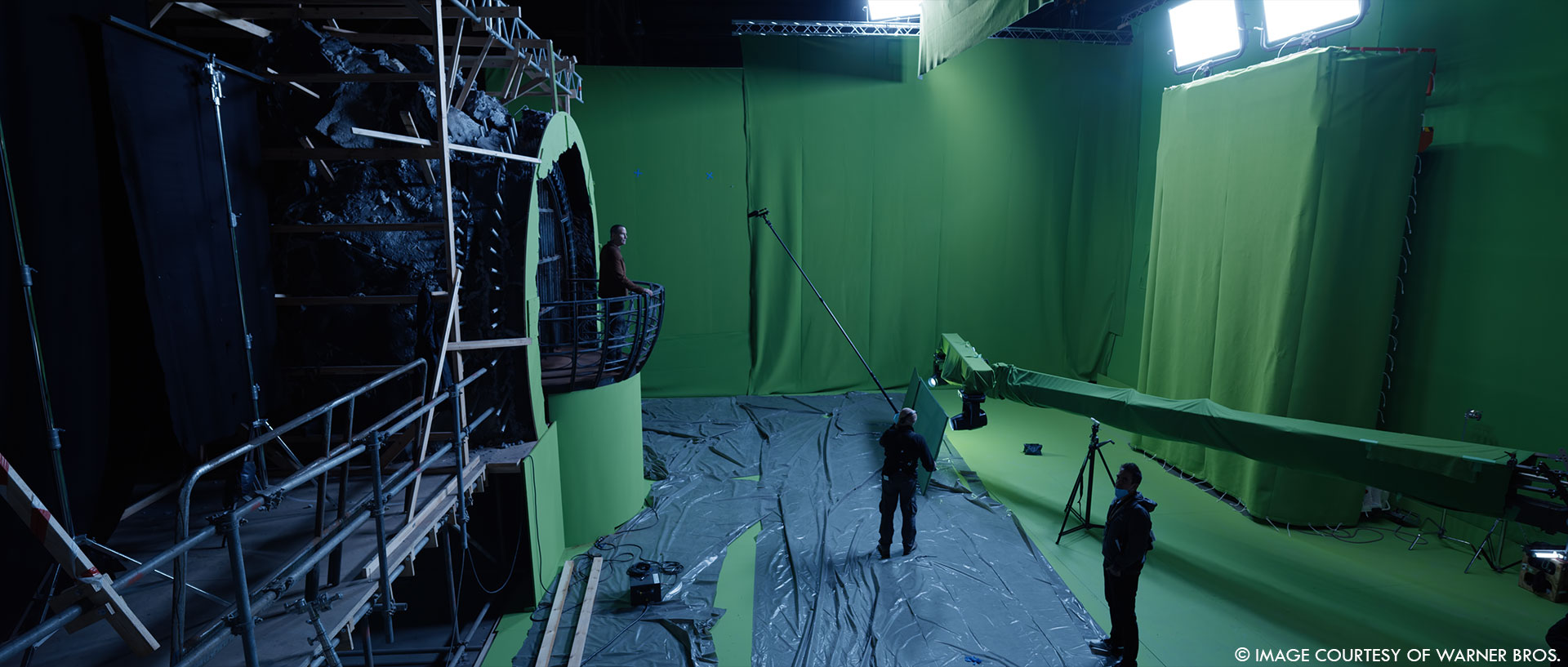
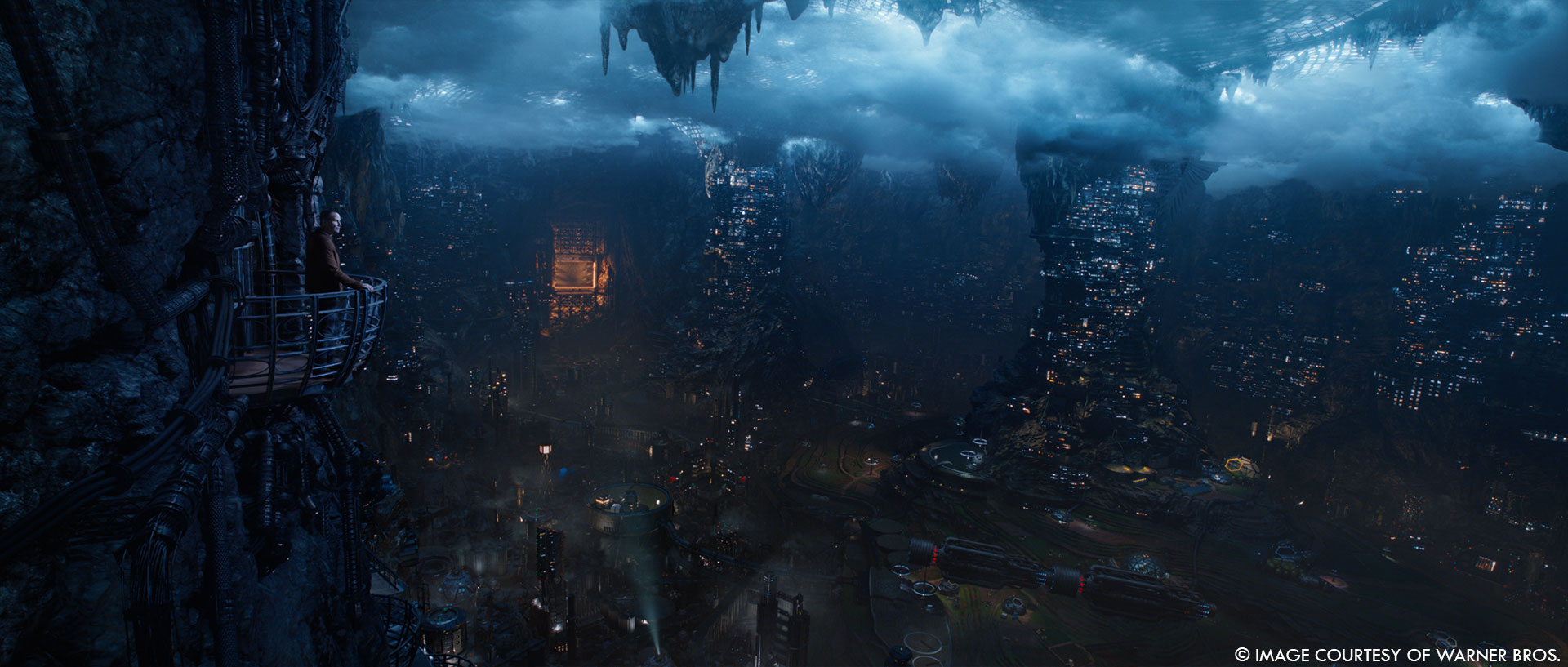
How did you organize the work with your VFX Producer?
HJE – Our VFX Producer on DNEG’s side was Beatriz Quintairos Suarez with Moriah Etherington-Sparks taking Exec Producer responsibilities. We divided the work between our London site which was the main hub and our Vancouver site with the team in India supporting both. We tried to keep the work split as sensible and as clean as possible to avoid too much crossover with the sequences which certainly helped with managing all the work, and I’m sure gave our marvelous production team a few less headaches!
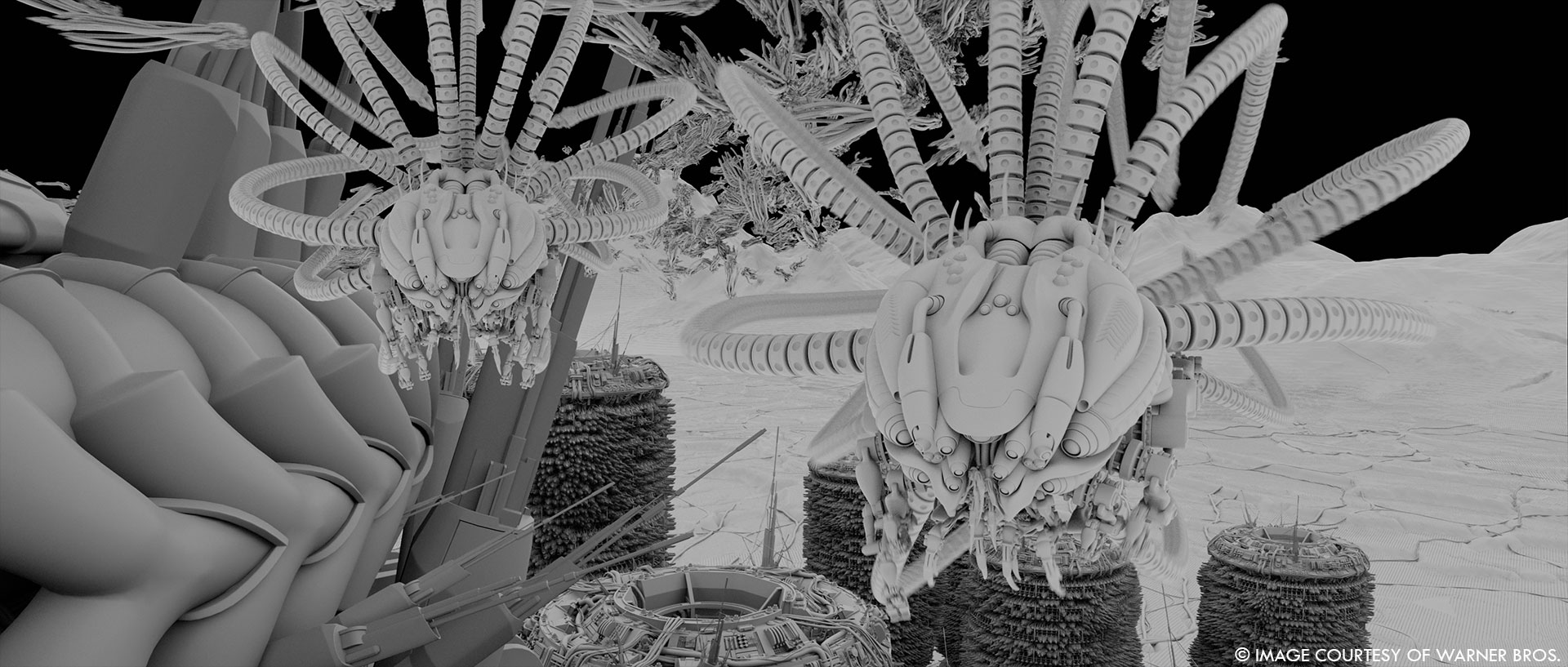
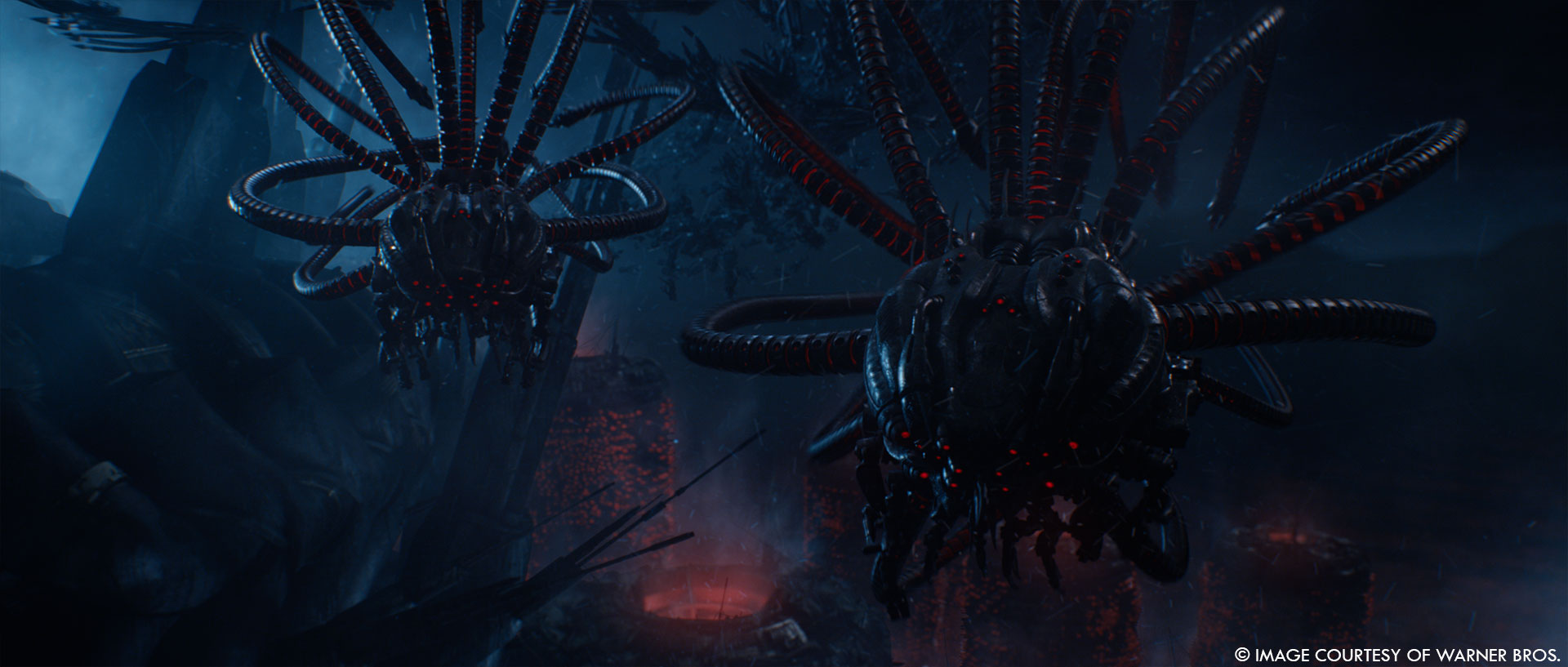
The Matrix movies have pushed the limits of the VFX. What were the main challenges with this new movie?
HJE – I think this movie had some very interesting VFX challenges overall. Things like a new type of bullet-time with custom camera rigs was certainly a challenge in general, but our biggest challenges at DNEG were probably shared between the sheer scale and density of detail required for the huge environment builds and our FX driven character Exomorpheus. He was a particular challenge conceptually in that some of his original tests were a lot more abstract and we had to really nail his ability to solidify into a human form that could deliver important dialogue and interact with the other actors convincingly. We had to figure out a balance between a soft flowing sea-grass type movement when he was at rest, to a more solid and tightly bound form wherever he’s using energy – be it in conversation with someone or climbing onto something perhaps. Our FX supervisor Mike Nixon was heavily involved in sorting all of this out.
Mike Nixon (MN) – The Exomorpheus was a big ticket item in FX. Working on a creature with subtle human expression paired with a mechanical presence was a huge challenge. Early tests were quite loose and abstract and hid his form too much. Then we looked more at his solid state, using strong magnetic forces to present a near perfect rendering while the balls would jockey for position while forming magnetic islands as they reshaped. This proved too perfect and solid, so we ended up finding a balance between the two approaches. Adding an additional layer of motion in the form of natural waves, that gave a very organic motion similar to seagrass caught in underwater currents.
We were constantly adjusting the weighting in the Exomorpheus features depending on requirements of the shot. Collisions and fluids were used with a variety of waves and forces to produce his elegant form, matching his motion and expressive state.
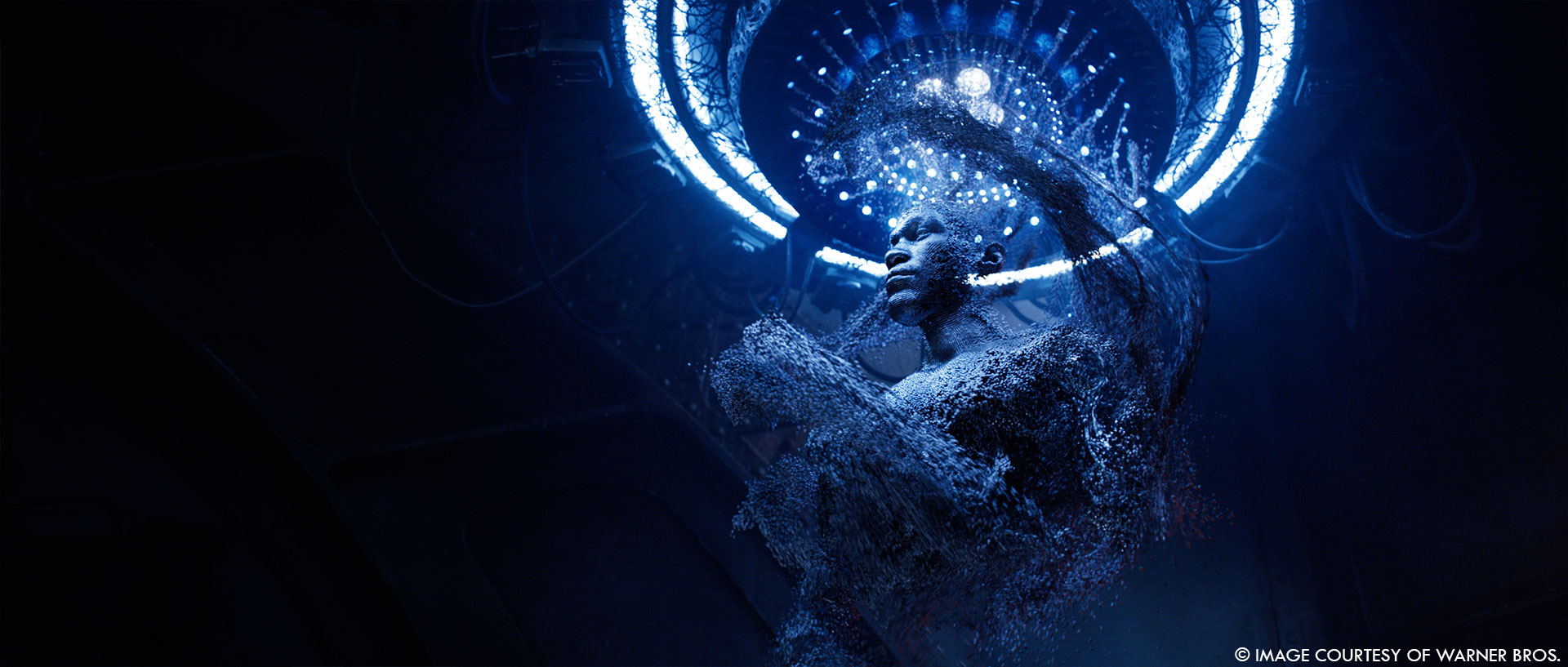
Where were various parts of the movie filmed?
HJE – For the sequences we were tasked with at DNEG, they were mostly all shot in and around Berlin, either on the sound stages and backlot at Studio Babelsberg or nearby in the surrounding area in some cases. The rest of the movie had sequences shot in and around San Francisco.
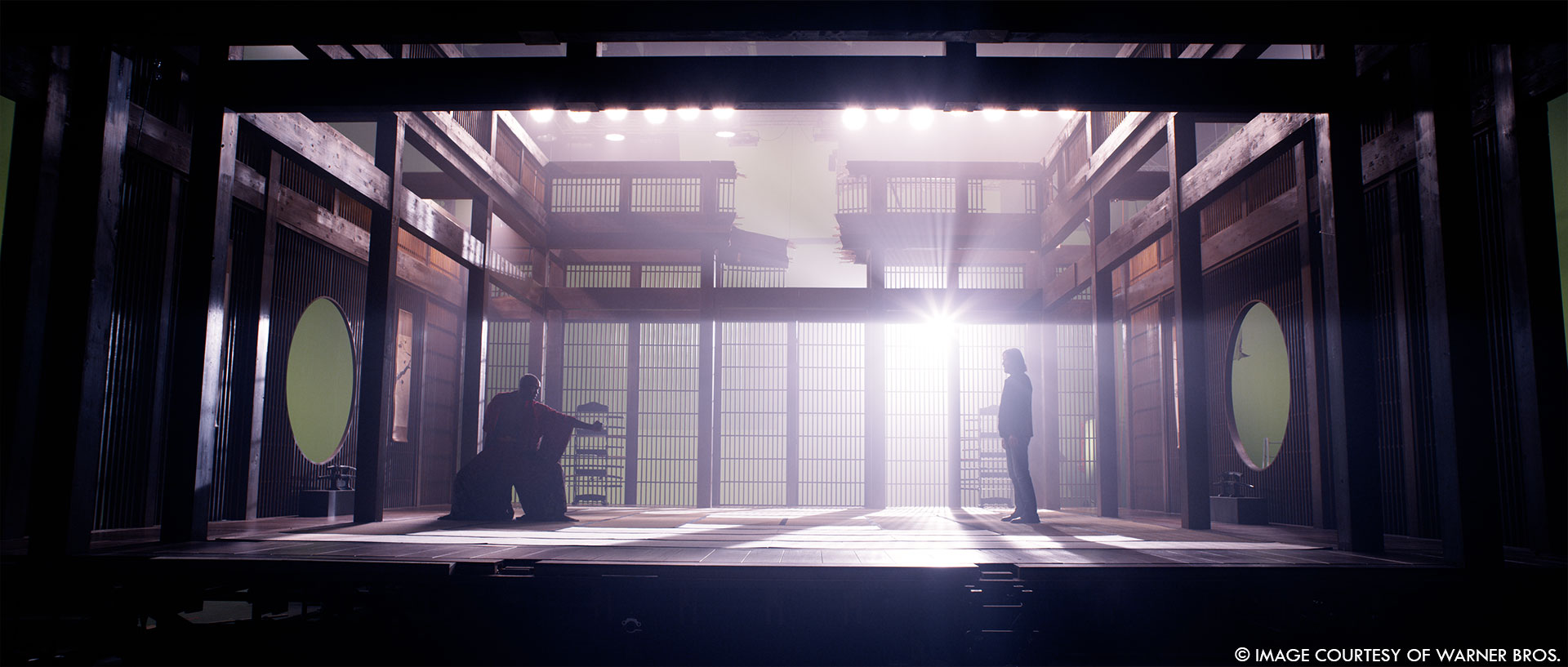
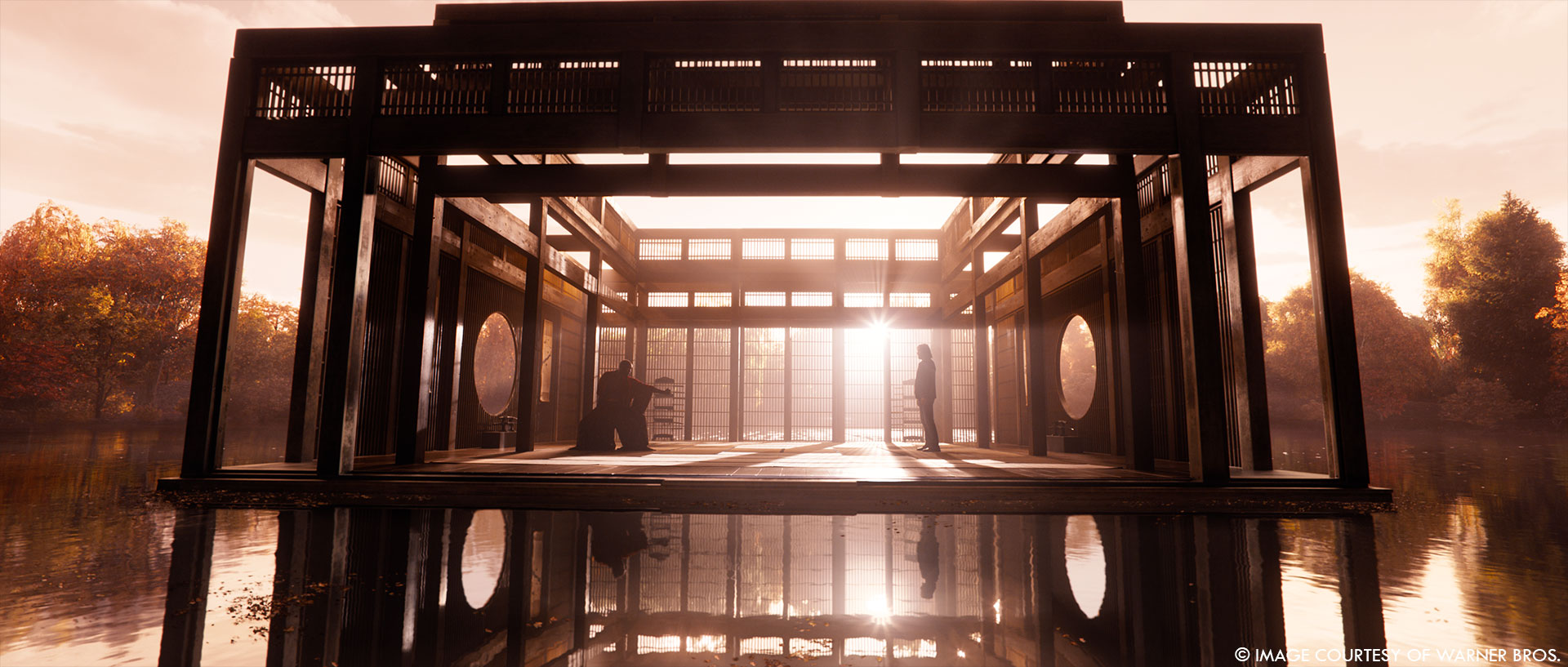
Can you elaborate about your work on various environments, such as the beautiful dojo and the new city IO?
HJE – The Dojo sequence was an exciting prospect for us. Lana had already started work with the team at Epic, creating an environment in Unreal inspired by the Devil’s Bridge in western Germany, where a semi-circular stone bridge gives a perfectly circular reflection when viewed from the right angle. This was adapted into three large circular lakes interconnected with these bridges and surrounded by a sea of trees as far as the eye can see, with the dojo sitting right in the middle of it all. With the whole idea of the Matrix being this artificial construct, we relished the idea of taking this Unreal environment created in a game engine and running a whole sequence of over 100 shots for a live action feature film with it. Our own little Matrix within the Matrix. Environment Supervisor Ben Cowell-Thomas was tasked with taking this environment under his wing, supported by DFX supervisor Robin Beard.
Benjamin Cowell-Thomas (BCT) – This was the first time DNEG had used Unreal as a renderer to deliver full quality images ready for screen, this really was the bleeding edge of what Unreal can do, and so our CG supervisor Roel Coucke and lead James Tomlinson liaised with the team at Epic to deliver us engine updates that allowed us to output aovs and handle some of the other scene organization required to deliver shots to compositors.
The Unreal work was complimented by a beautiful 360 sky matte painted by Sullivan Richard.
The Dojo itself was a physical set although in some shots such as the explosion or the wides we replaced this with our CG double, allowing the FX team to blow it apart.
MN – The Dojo destruction was a fantastic sequence to work on. Simulating the big wooden beams splintering, and the shockwave ripping it apart, sending the debris smashing into the water and rippling off the surface was a complex task. Made more difficult by the interaction with the unreal trees which were exported back into Houdini. This allowed us to rip leaves and little branches off, while swaying the trees and emitting dust off as the pressure wave collided with them.
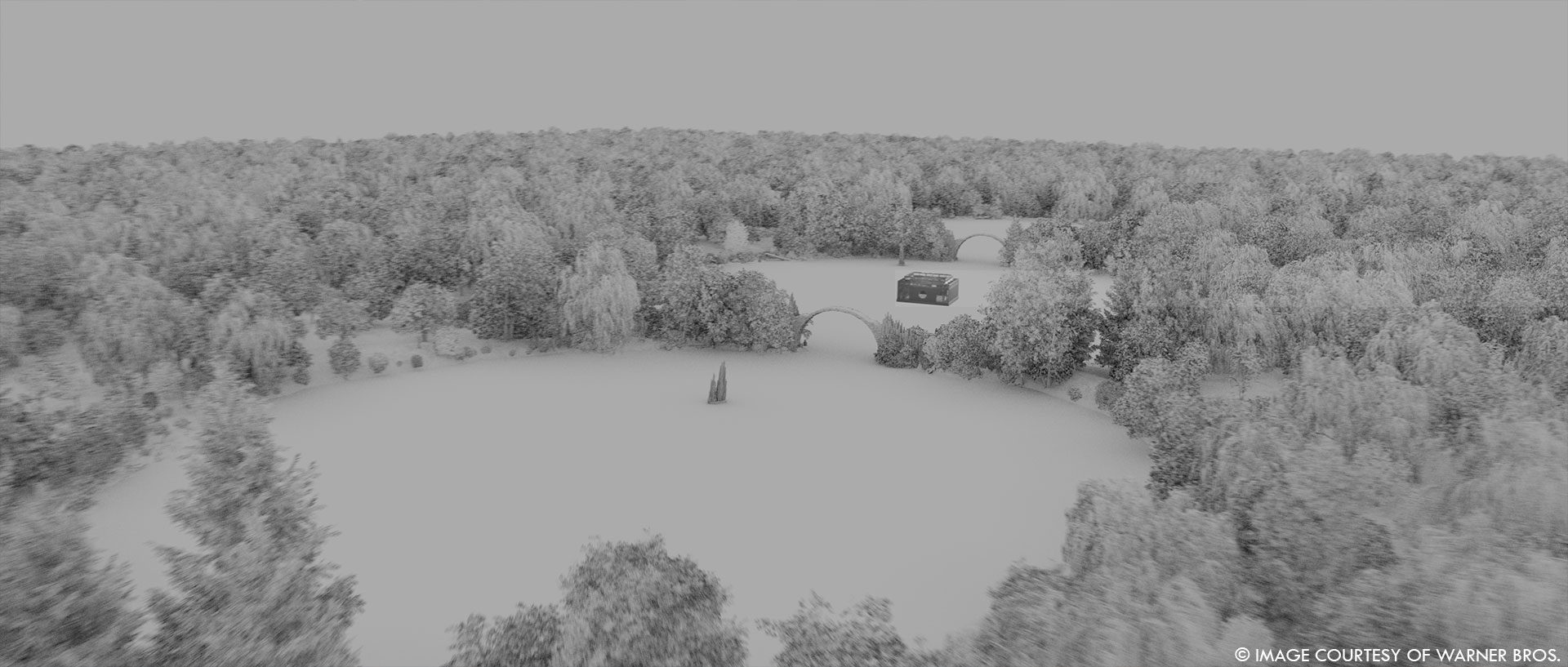
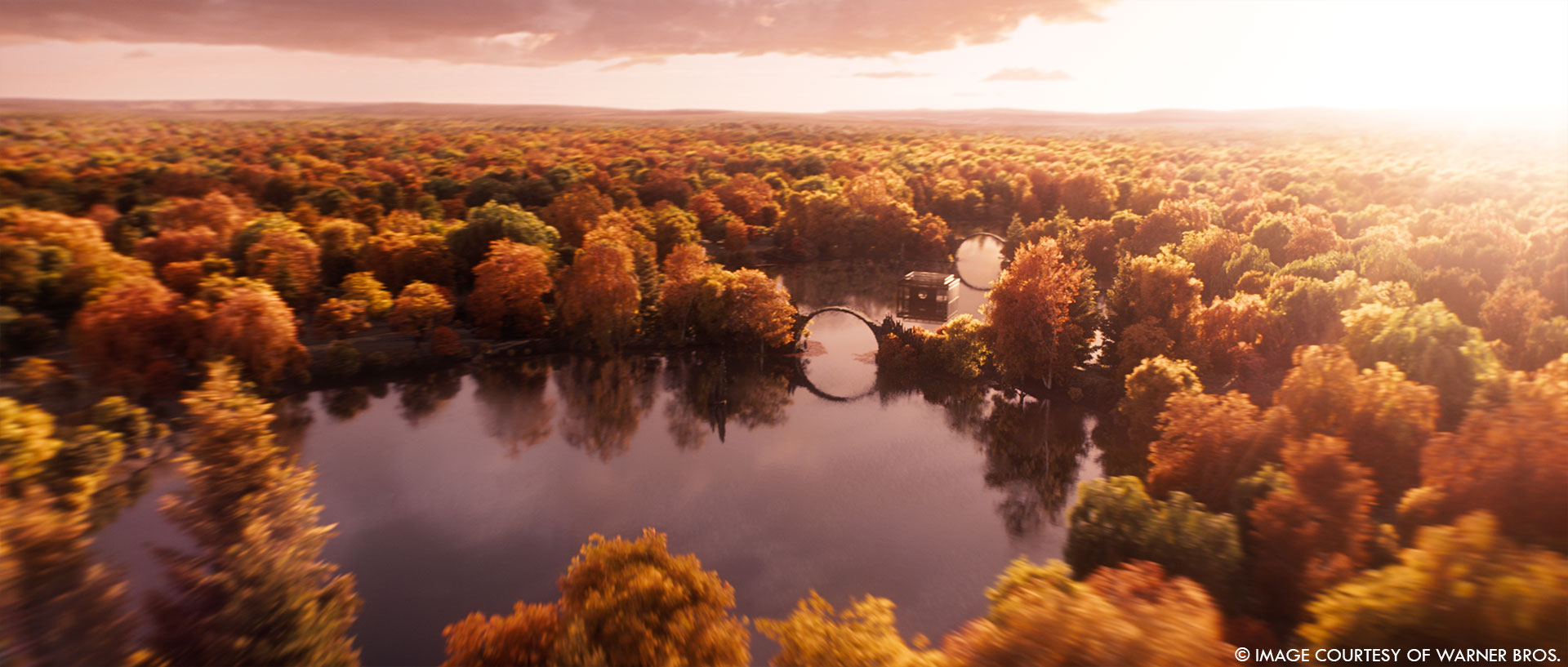
HJE – For the IO environment, our main challenge was a matter of sheer scale and complexity of detail. If Zion from the previous movies was a town then IO would be a megacity. It required a lot of careful planning and design, but luckily again we had Environment Supervisor Ben Cowell-Thomas and his team taking care of this block of work, again under the supervision of DFX supe Robin Beard
BCT – This was a real treat for us as a team, creating a vast CG city from scratch that had to work from every angle.
We had some great concept art, as well as some references of generative 3D art and sculpture. Lana was keen to show that the friendly machines had helped in the construction of IO and so this more mathematical and procedural reference contrasted against the more haphazard human construction. I expanded on this reference by looking at densely packed blocks in Hong Kong and South America, brutalist architecture, oil rigs, and oddly enough constructions from Burning Man! We didn’t look at any sci-fi reference at all as we really didn’t want to have a generic sci-fi look, this had to be a plausible gritty place rather than some fanciful vision of the future.
I started by blocking out the space of the city and the long cave leading up to it as defined by the concept art and a rough previs model. Looking in detail at this space with IO environment lead Roger Tortosa Aras we decided to go with a modular approach, creating a series of rocky building blocks that could be arranged to form the cave walls. This reduced our workload greatly as if these building blocks were detailed up to look real, then the entire cave would look real. Careful arrangement along with the lighting meant that no repetition would be perceived.
The city was formed of three zones, the industry spread out on the cafe floor, farms grouped around the middle in a tiered arrangement and residential ‘stacks’ that loomed over the world and echoed the towers of the machine city. We spent a great deal of time and effort thinking through the logic and arrangement of all these zones, with tiny pipelines, walkways and many details barely visible all forming together to create a plausible whole. There was also a hero overlook area created by Will Foulser and the dock which was handled by the build team overseen by James Benson.
Very little of IO was procedural, we did explore using city generation tools but we wanted the feel of a city constructed by many individuals over time using salvaged materials. In the end we found that hand constructed ‘modules’ that were then arranged to form larger modules gave us a much more chaotic yet plausible result. Following the logic of the movie we did however create some of the machine elements procedurally, this contrast of handmade and mathematically driven structures suited the narrative of the space.
Myself, Roger and the whole environment team relished this work and I think the enthusiasm that everyone brought to the project really shows on screen.
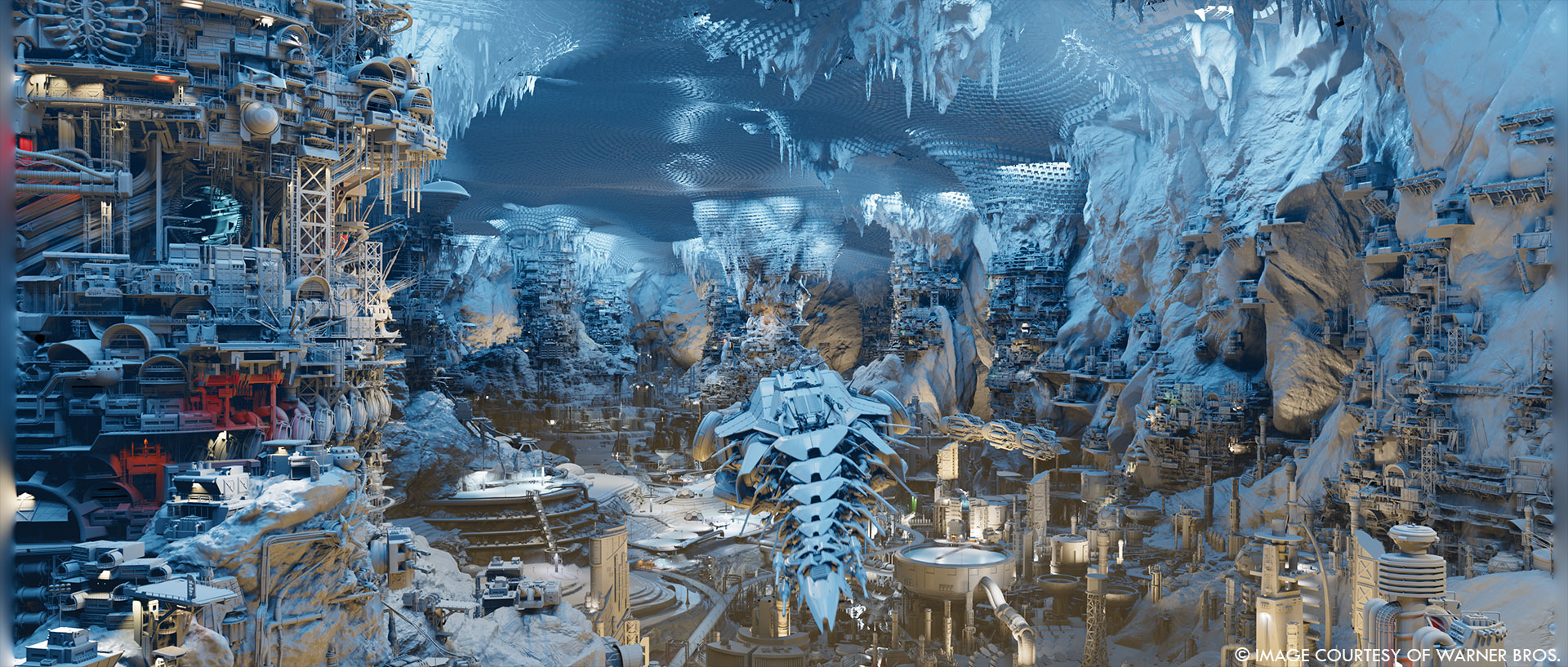
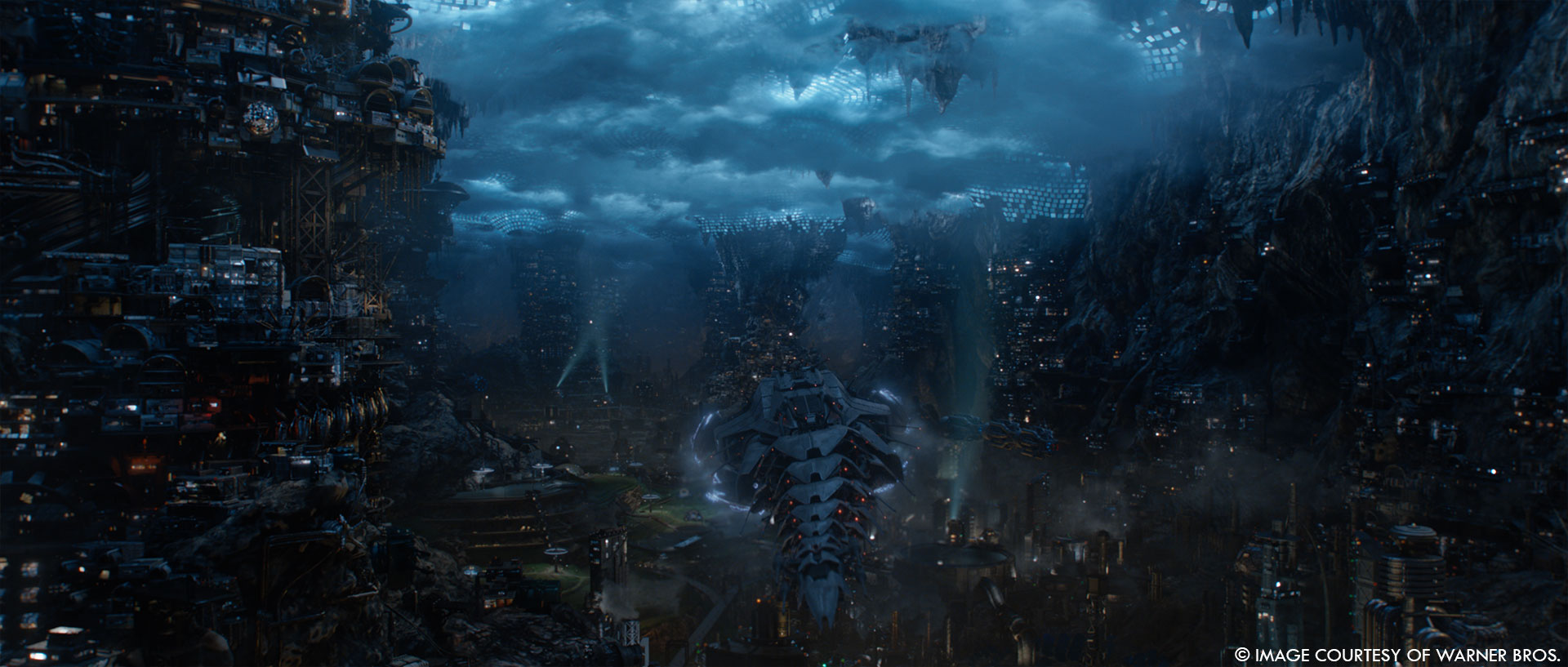
The dojo and IO have distinct lighting. How did you achieve this look?
BCT – The Dojo was lit by a low early evening sun, which we then complimented with fill lights to pick out areas of vegetation as shots demanded.
HJE – One thing that was great about working inside Unreal was the freedom to play with the lighting and get a very quick response. Being able to block out a whole sequence of work with minimal crew and allowing us to generate a whole sequence of work quickly for review was invaluable. Normally we’d be trying to set a sun position and roll it across all the shots for continuity; however, we also had to match to the practical set lighting in the dojo and on the characters which had creative adjustments per shot to get the best out of the photography, so this certainly kept us on our toes with lighting tweaks per shot to get as close a match as possible, while still feeling believable.
BCT – IO being in an enclosed space was tricky to light, we worked closely with the lighting team to give them locators that allowed them to procedurally add physical lights that made sense in relation to the walkways and structures, and they then expanded on this by adding the beautiful dramatic lighting you see on screen.
HJE – One design feature of IO that really helped us here was the bio-sky; an array of panels suspended around the cavern ceiling that artificially light the whole environment like a faux sky, even generating clouds and oxygenating the air. Having this key source of light really helped sell the mood and bring some much needed ambience into the dark cavernous space. It was all about showing how much more advanced the humans can be when they work in harmony with the machines or synthients, rather than living as ‘us’ and ‘them’.
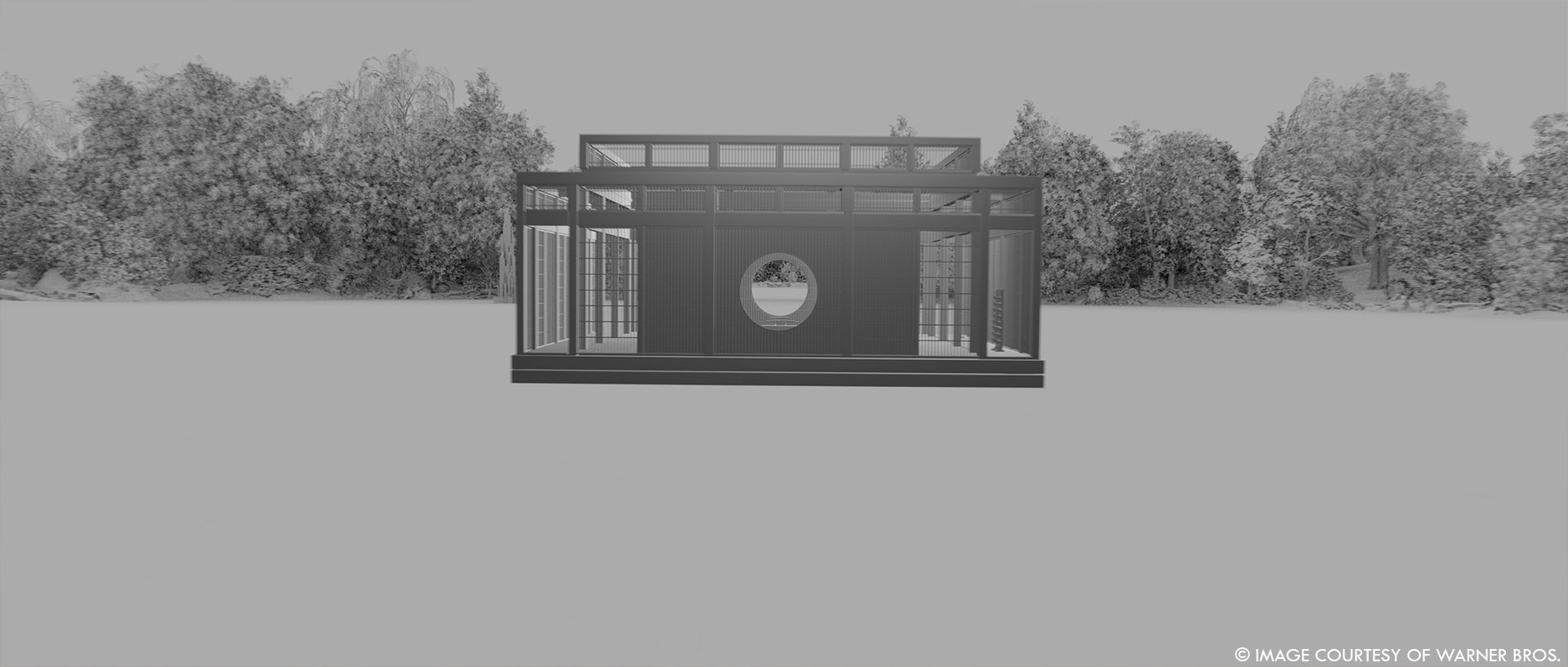
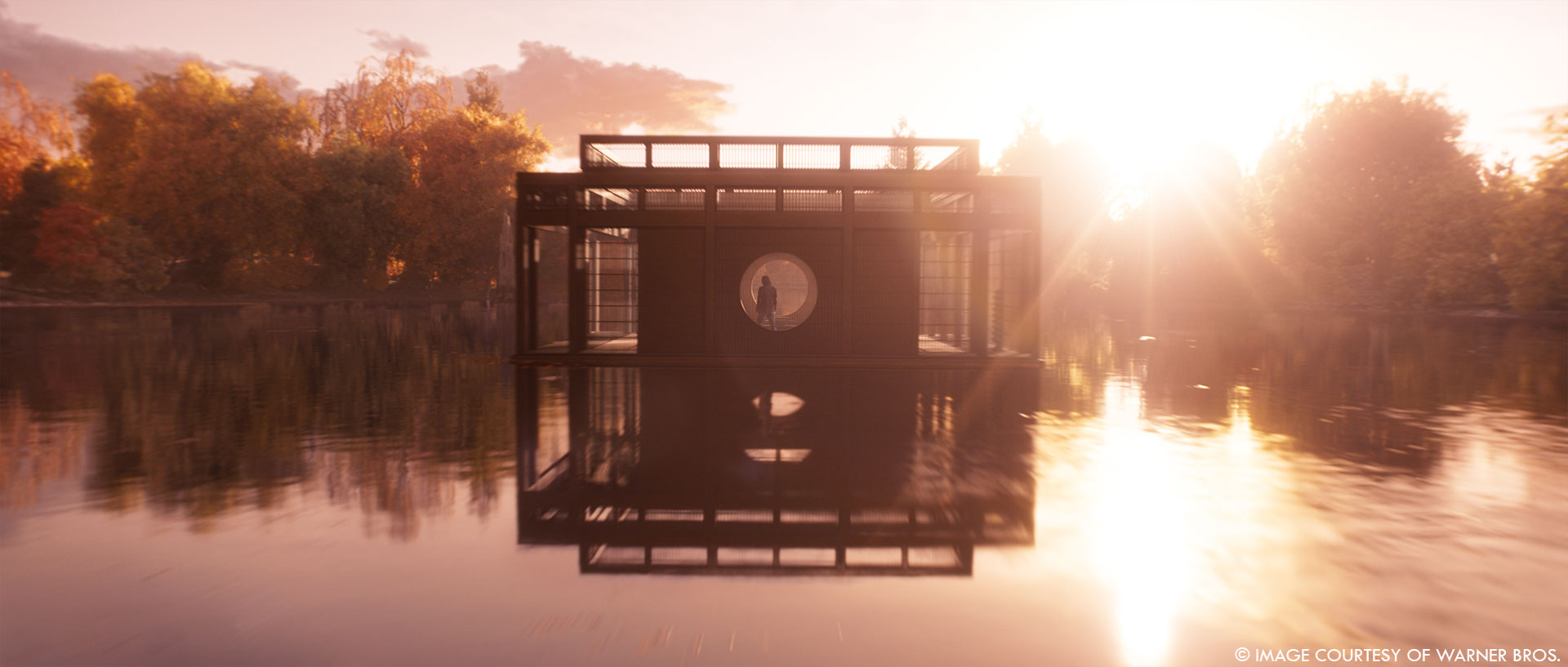
Can you tell us more about the impressive machines environment?
HJE – Absolutely! This had to be one of my favourite environments on the project as it just takes you right back to those first moments in the original movie when we first hear Morpheus explaining what the Matrix is to Neo and what the machines are doing to draw power. We had perfect reference imagery from the original trilogy to help get us started – we even sourced as much as we could in terms of original assets from 20 or so years ago which was a challenge in itself! It’s not like they were all kept in a vault so we could just grab everything, they were spread across various companies, some having old copies on old servers etc., so a few email threads later and we managed to restore an old Harvester, Sentinel and a Foetus Stalk, which was super exciting to open up and see. These needed to be rebuilt with updated topography and additional geometric details added and textures re-painted so they’d hold up to today’s standards – particularly at 4k resolution. It was very exciting to see these iconic models. With this movie being set 60 years later, Lana was keen for us to show how the machines had adapted to their environment to account for the extra power they need so while we were referencing the originals, they needed some upgrades and some re-thinking too. The environment was split into three main sections: the Foetus Fields, the Power Stacks and the Roots. Environment Supervisor Ben Cowell-Thomas was on hand to help figure this all out under the supervision of DFX Supervisor Steve Newbold.
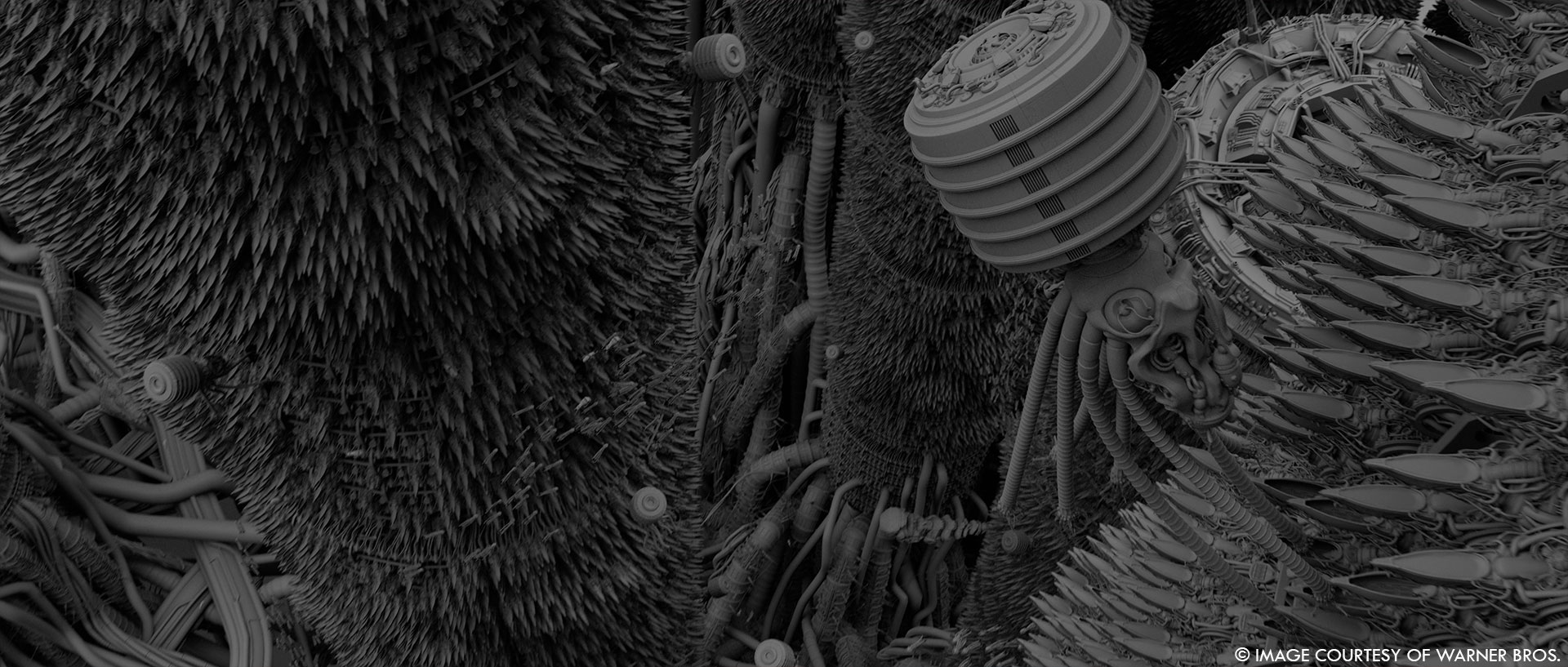
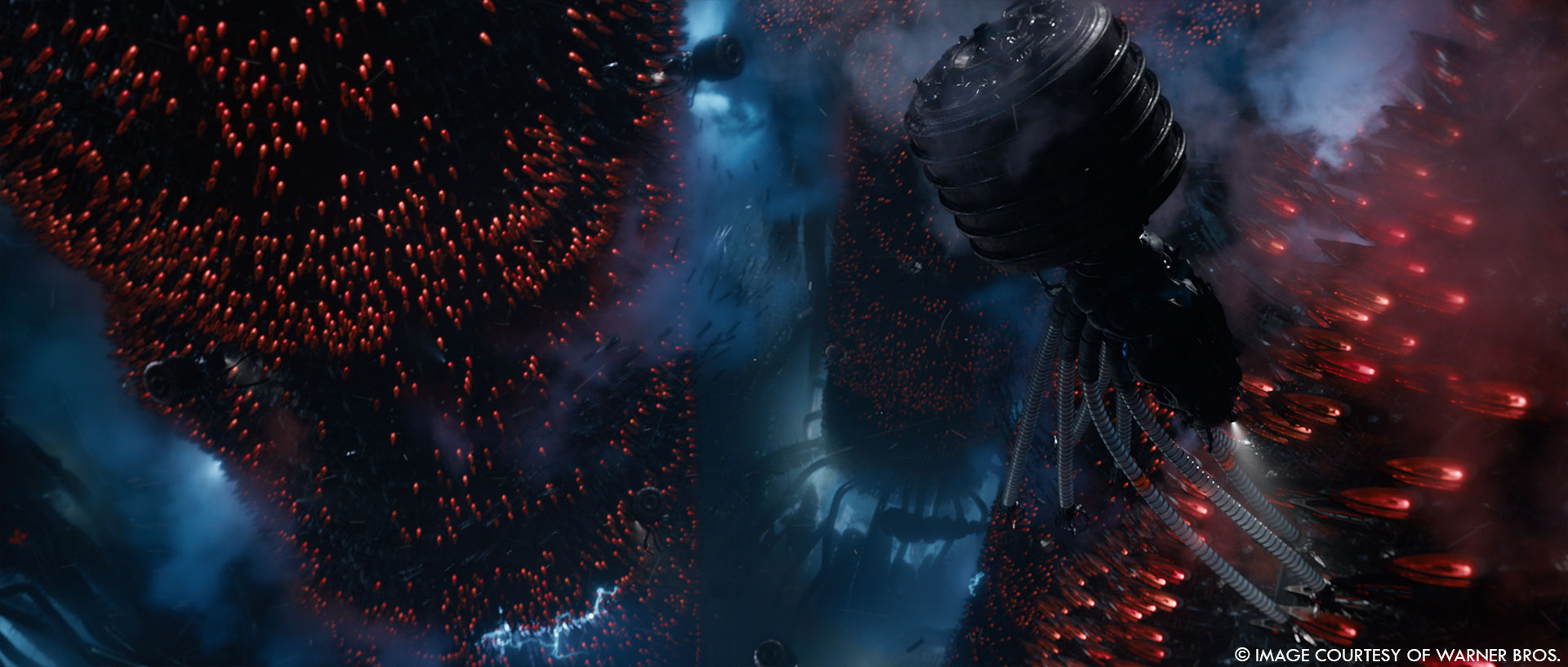
BCT – Being entrusted with a sci-fi icon such as the Power plant from the original Matrix trilogy was both an inspiring and daunting prospect. This was a huge build, led by Arvind Kachare and Davide Prato. In contrast with IO this was heavily procedural, after laying out the rocky ground we scattered more than 6 million podstalks. The stacks in the centre were an expansion on the original films, Davide used Houdini to construct the towers from modular parts, packing in extra bulging clumps of pods to show how the machines have jammed ever more humans into their power plant.
The roots below were constructed in much the same way, blocking things out roughly and then detailing and expanding using tools created in Houdini. We built so many pipes and tunnels in this movie that we had to create a custom pipe and tunnel detailing tool – this became useful in just about every environment we created!
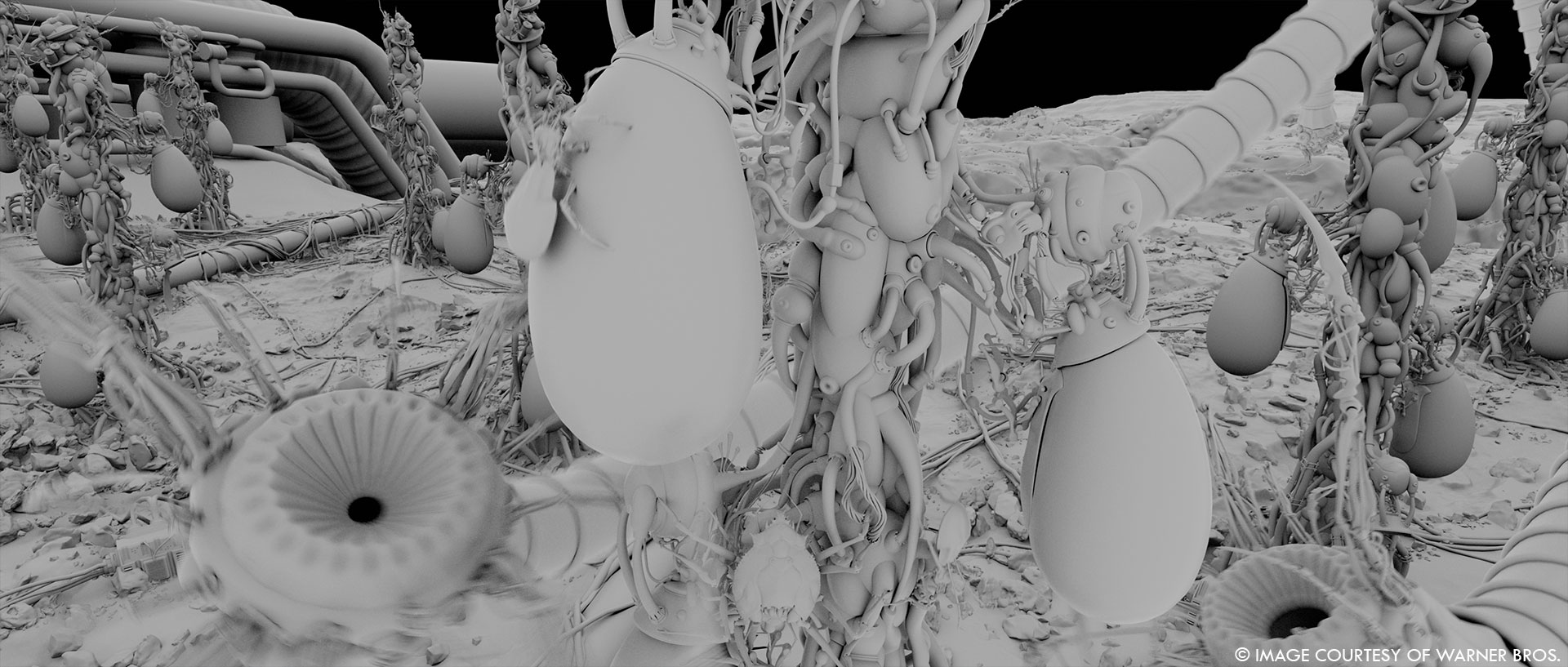
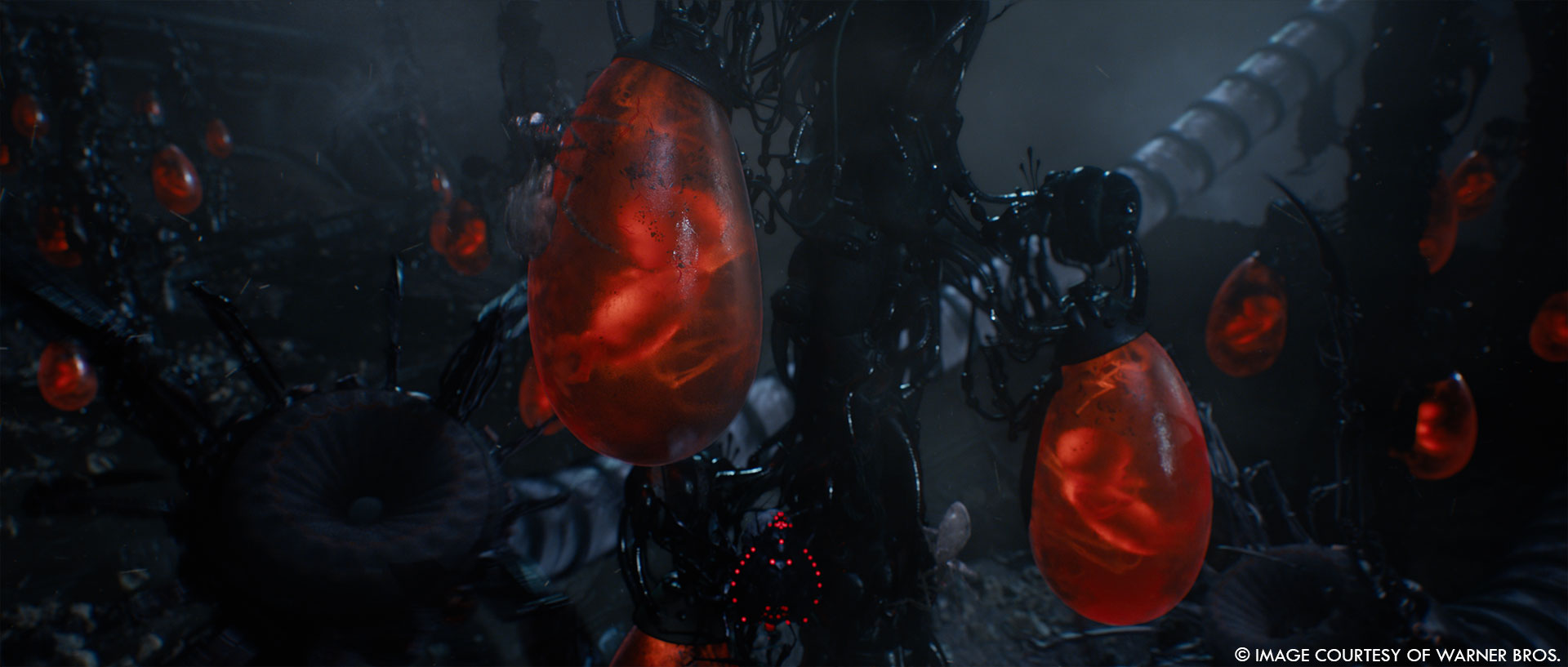
Also on the topic of machines, can you elaborate about the design and creation of their “new look”?
HJE – We had some really interesting creature work on this project. Primarily the ‘synthient’ creatures which are living alongside the humans now. We did revisit some iconic machines such as the Harvesters, which certainly had some updates done in terms of modelled details and certainly textures and shading so they held up at 4k rendered resolution and in our closeups. There was also the Sentinels which also had a similar upgrade. We had to be careful we didn’t introduce anything too different in this case as Lana would describe these machines as the cockroaches of the Matrix world, unchanged over the years – just a little more worn and weathered – but still surviving as they always have. The newer machines (or synthients) did have some fresh designs. We had Cybebe, Octacles, Lumin8 and Kujaku. They each started out as concept artwork and evolved as we figured out the details and mechanics of how they all worked. We knew these characters would feature in close-ups and in some cases interacting with the actors so we had to work heavily into these designs. Both the modelling and the rigging process had to remain iterative and flexible so we could start blocking out animation and poses with Lana to discover the points of articulation required on the characters. There was a constant back and forth between the build and animation teams as we needed to adjust and adapt based on the performances that Lana was looking for. Our Build Supervisor James Guy took charge of these sentient creatures and guided his team of modellers as we figured this all out, talking closely with our Animation Director Keith Roberts. In terms of design, we tried to keep them sitting within the already established world of the Matrix, so they were primarily metallic, sometimes borrowing elements from other creatures such as sentinel legs in the case of Cybebe’s tentacles. We were also trusted with coming up with some entirely new creature designs for the microbots which feature in a few places – namely the Anomaleum where Neo wakes up in his pod, the Root section in the power plant where Neo is carried through after being extracted, and also the Machine Lab where Neo and Trinity are being operated on during a flashback moment. Our concept team took reference from Geof Darrow’s artwork and designed a whole host of organic / mechanical hybrid bots that were fun to build and ultimately animate. Our Animation Director Keith Roberts and his team did an incredible job helping to populate these creatures around each environment.
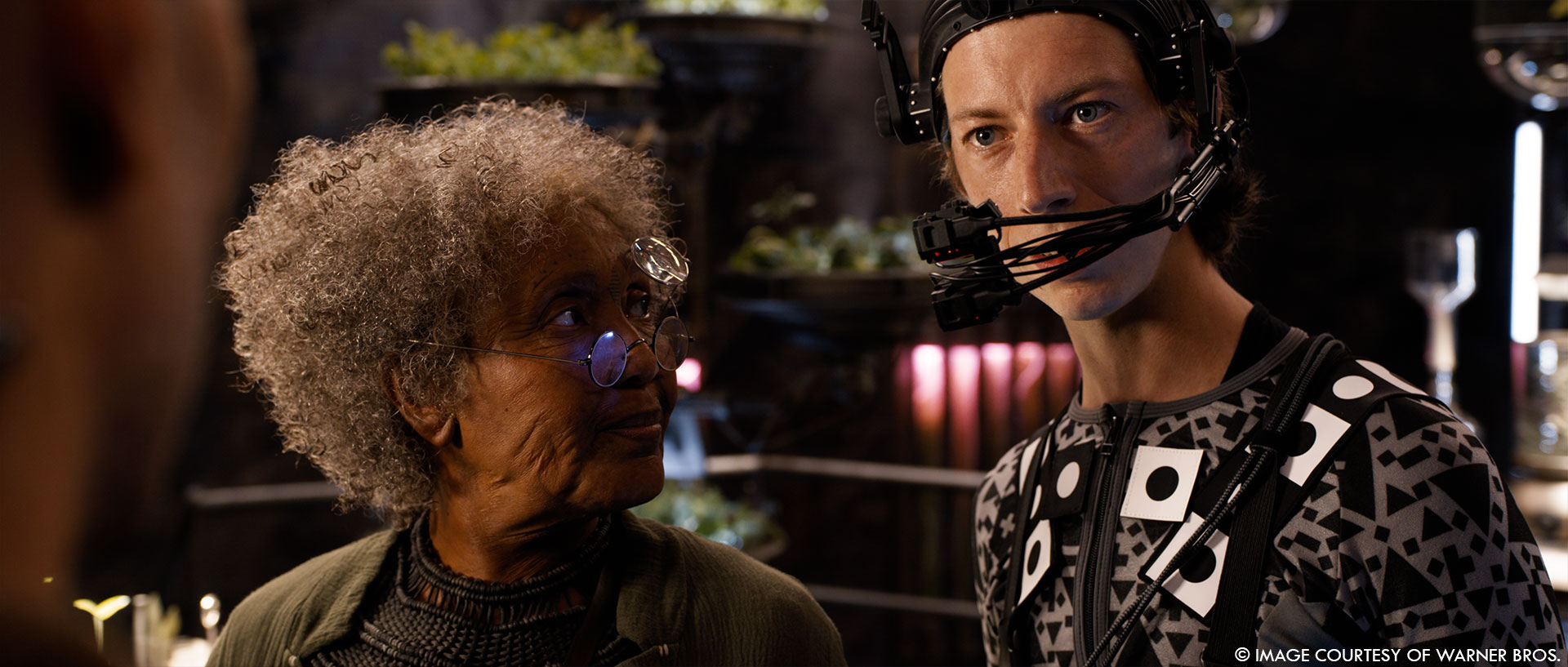
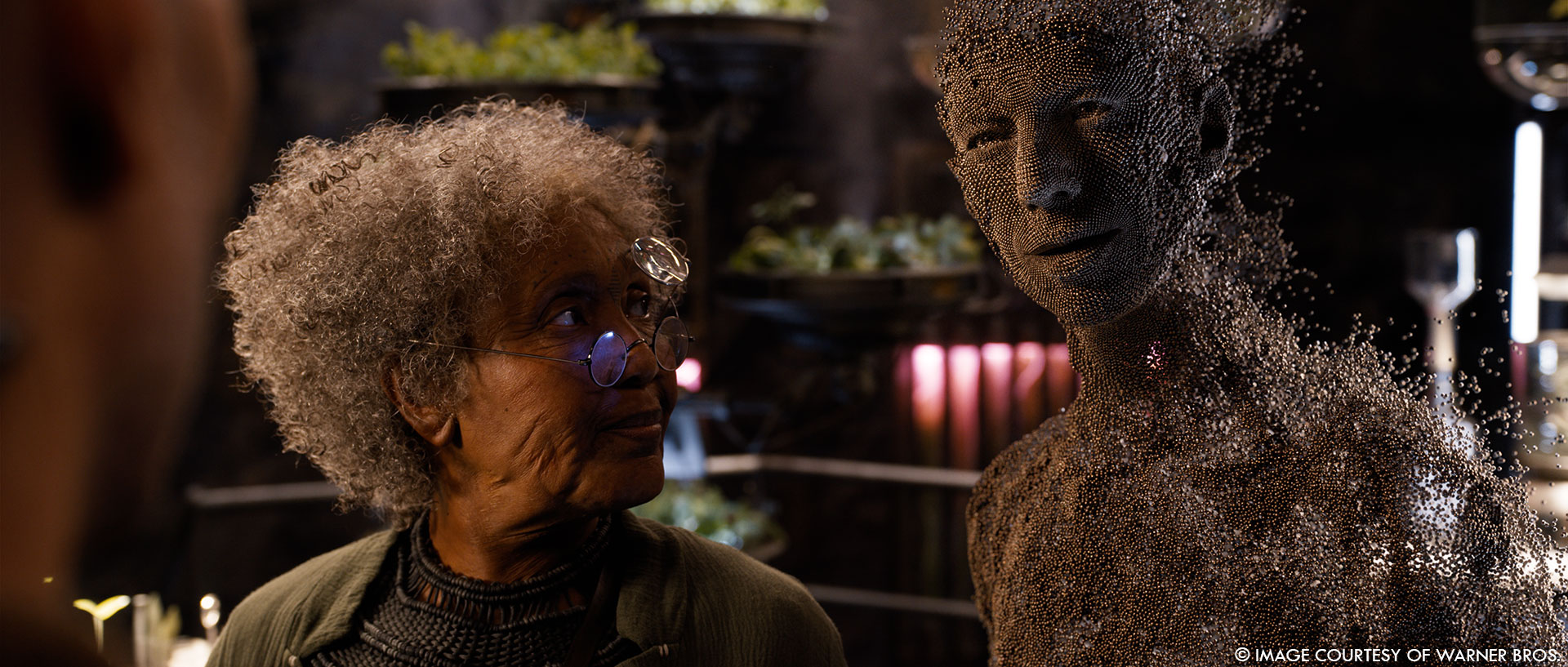
How did you handle the animation challenges?
Keith Roberts (KR) – The animation challenges were numerous on the show, the creatures were fun as they were very unique in shape and design. Cybebe for instance is as big as a bull but we had to make him seem friendly. Kujaku had many different creature elements so we used all kinds of inspiration from manta rays, an octopus and large winged birds. Lumin8 was a fun one too, unusual shapes to pull together. Pete Clayton, Tom O Flaherty and Hitesh Barot supervised teams in London and India, Leo Bonisolli supervised the team in Vancouver.
As a team, we also had a challenge with the Exomorpheus and Quillion characters. We used a blend of DI4D 3d caches and a fully tricked out face rig with the usual high number of blends and correctives. In some cases the cache was better, in other cases the keyframe performance was better, we also blended some shots. We loved seeing what the FX guys did on top of our anim with the tiny spheres. There was a feedback loop to tweak certain aspects but we were always impressed with what those guys added.
There were also lots of minibots in the flashback sequence, the ships, as well as many many sentinels with 18 tentacles each! We used some proprietary rig solutions to help with the tentacles. Overall I had a blast and feel very privileged to have been involved.
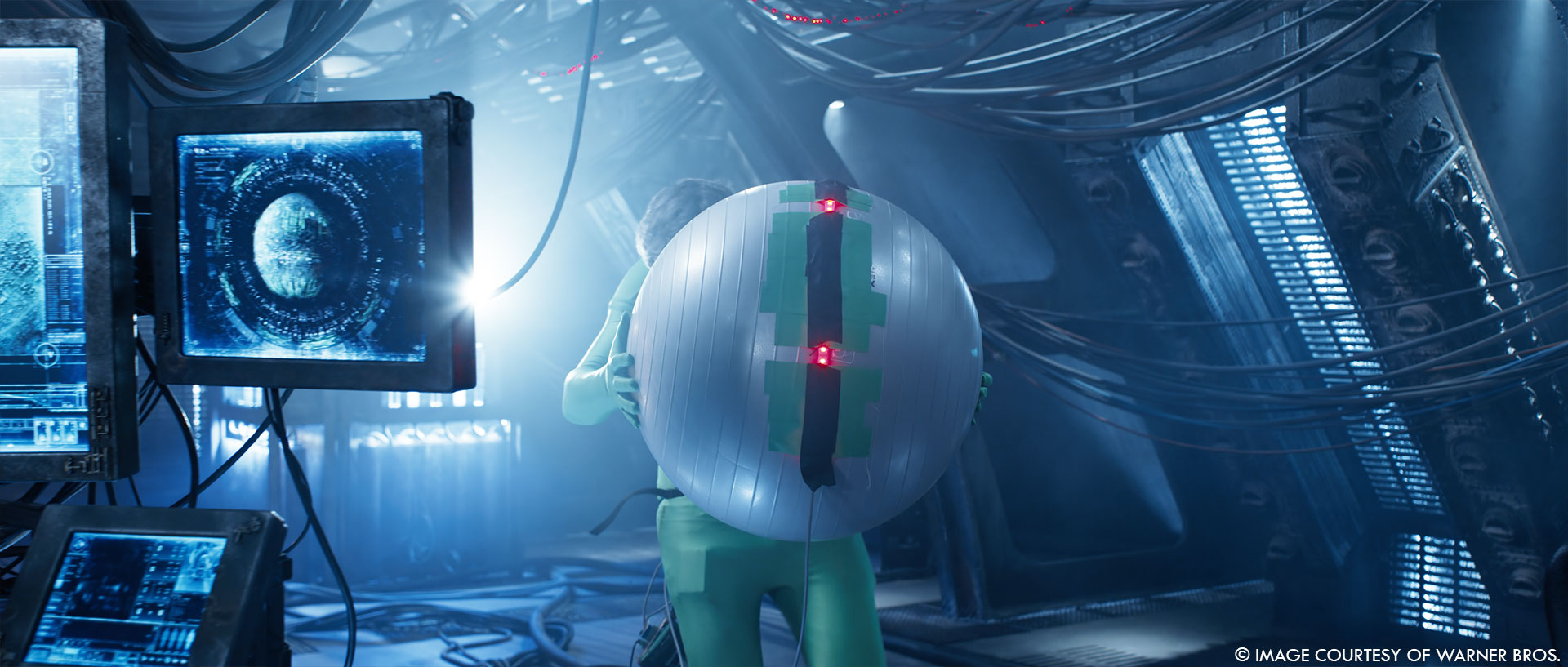
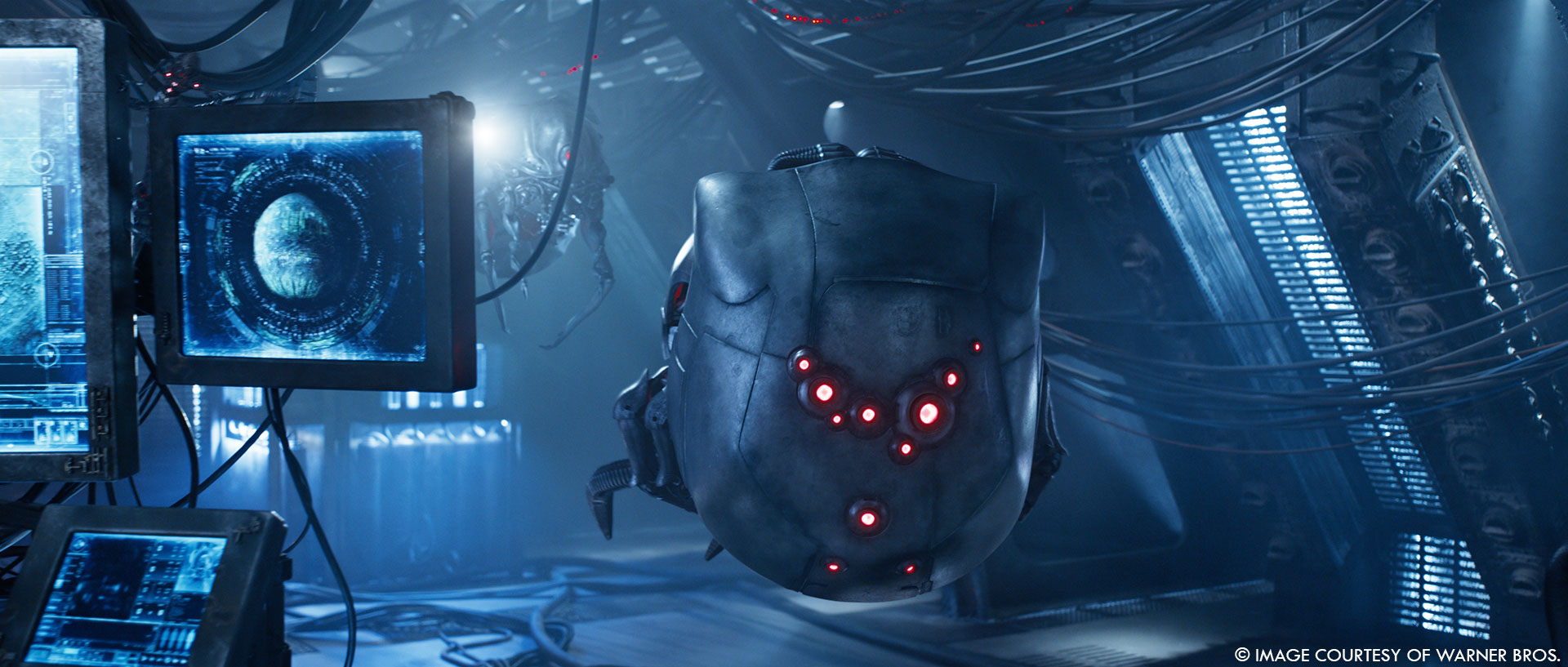
Which sequence or shot was the most challenging?
HJE – The whole show was challenging! Our massive environment builds were certainly right up there, as was figuring out how Exomorpheus would work. I guess one thing that maybe wouldn’t look that challenging but caused us a bunch of headaches was the CG cabling and tubes that are attached to Neo’s body when he wakes up in the Anomaleum chamber. We had to individually track all the practical ports on his body matching them to his muscles flexing and his skin sliding, then simulate these CG cables coming from each port, then integrate CG goo dripping off Neo and onto these CG cables, then integrate the CG cables into the practical goo in Neo’s pod as they slosh around while he moves. That was a big challenge but hopefully one of those invisible effects that nobody notices we even did.
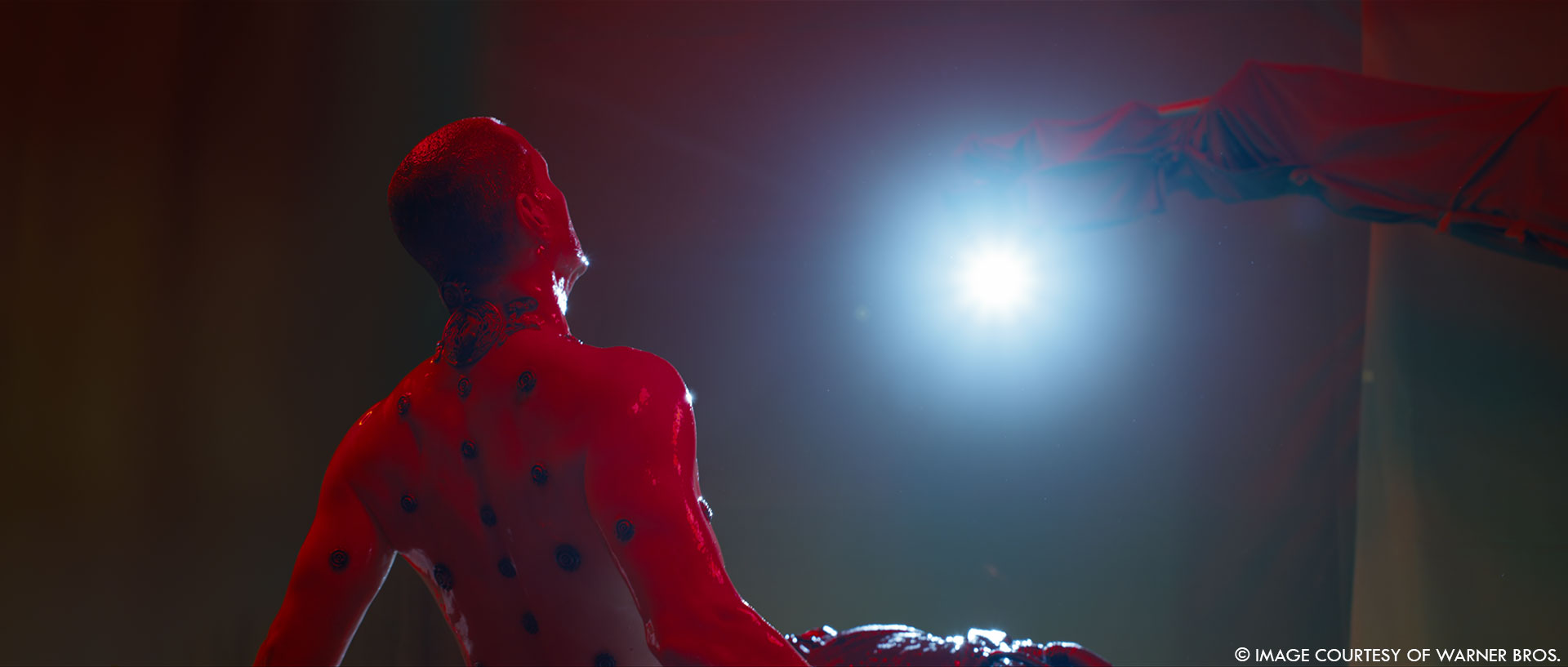
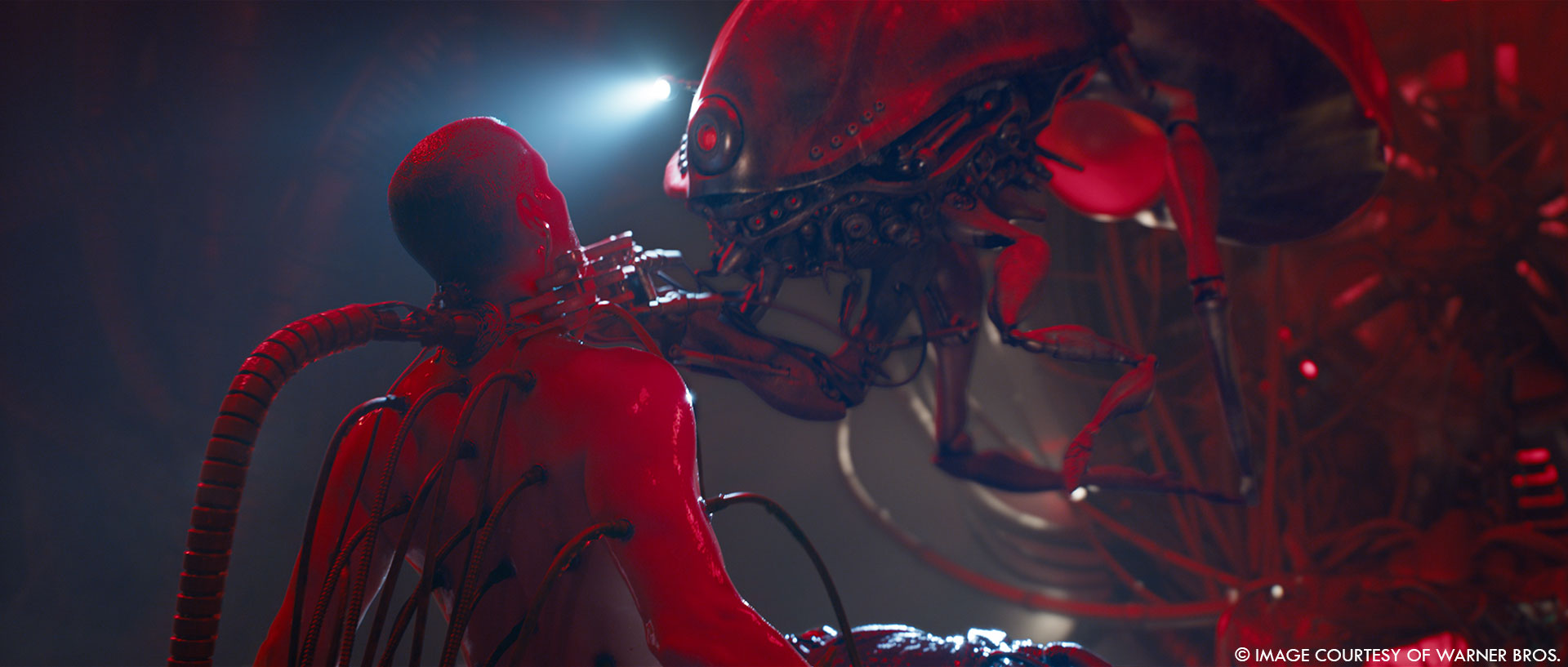
What is your favourite shot or sequence?
HJE – I’ve got a lot of favourite shots but I think my favourite sequence is probably the moment in the story where Sati is explaining the plan of how they’ll rescue Trinity and we flash forwards to the plan being executed – it’s basically where we’re in the foetus fields, starting with the shot of the egg getting plucked by the Harvester and the ship rising up majestically behind it with a powerful back-light. I just love how Matrix all that stuff feels and it takes me right back to when I saw the first movie for the first time. Then we’ve got Exomorpheus’ journey through these foetus fields on the back of a harvester trying to avoid the sentinels. Such beautiful shots with such scale. I just love those moments.
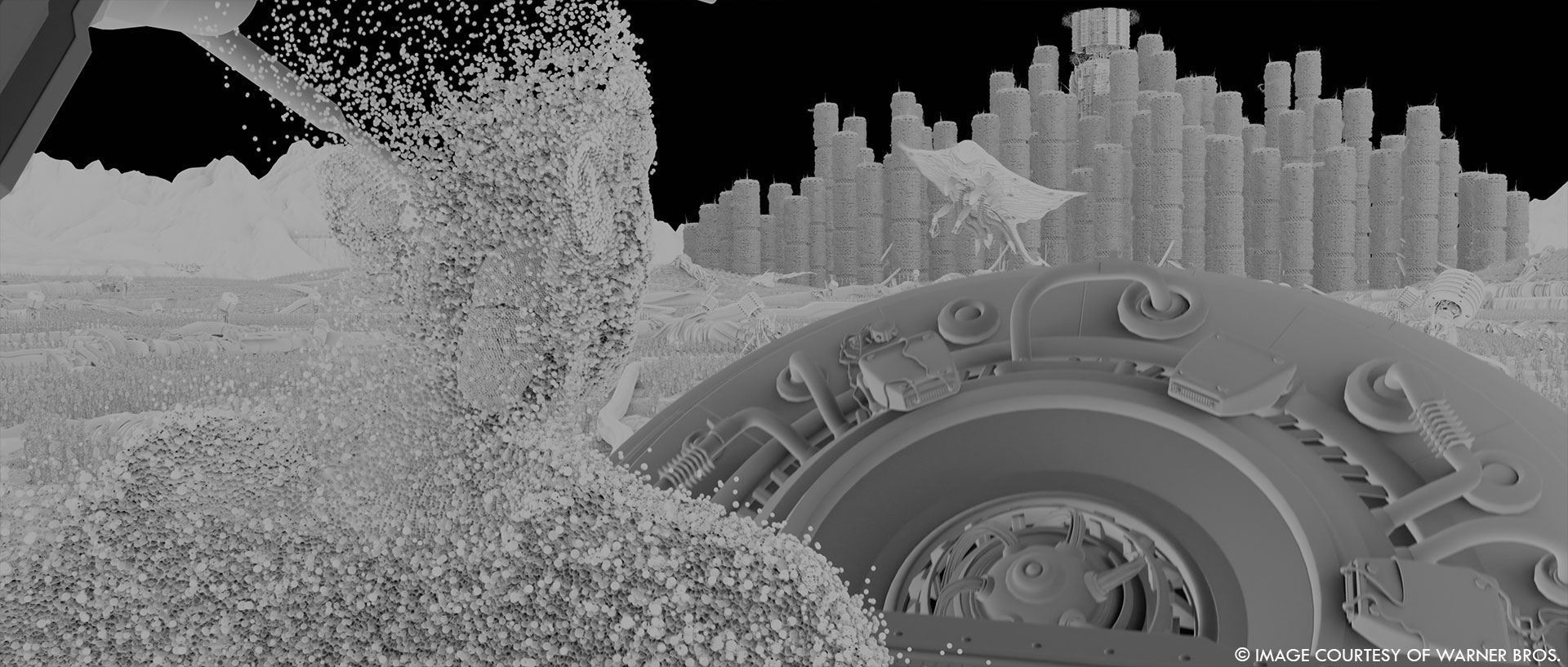

What is your best memory on this show?
HJE – Without a doubt, it would be getting to walk around the incredible sets and being part of the shoot while getting to see these amazing actors bring these iconic characters back to life before my eyes. Also, another career high would be donning the green lycra suit of invisibility and flying a yoga ball around the actors pretending I’m a machine while being directed by Lana was a moment I’ll never forget in a hurry! A moment I COULD forget in a hurry however was then getting these plates ingested back at base and the whole crew seeing them during dailies. Oh the joys of the job!


How long did you work on this show?
HJE – It was just under two years from start to finish.
What’s the VFX shots count?
HJE – Final shot count delivered from DNEG was 723 shots.
What is your next project or what are you working on now?
HJE – Personally I’m trying to catch up on a bit of sleep and get some rest before starting something new! Mmmm, sleep.
A big thanks for your time.
// The Matrix Resurrections – VFX Breakdown – DNEG
WANT TO KNOW MORE?
DNEG: Dedicated page about The Matrix Resurrections on DNEG website.
© Vincent Frei – The Art of VFX – 2022




